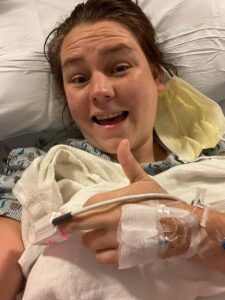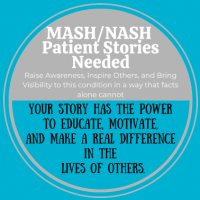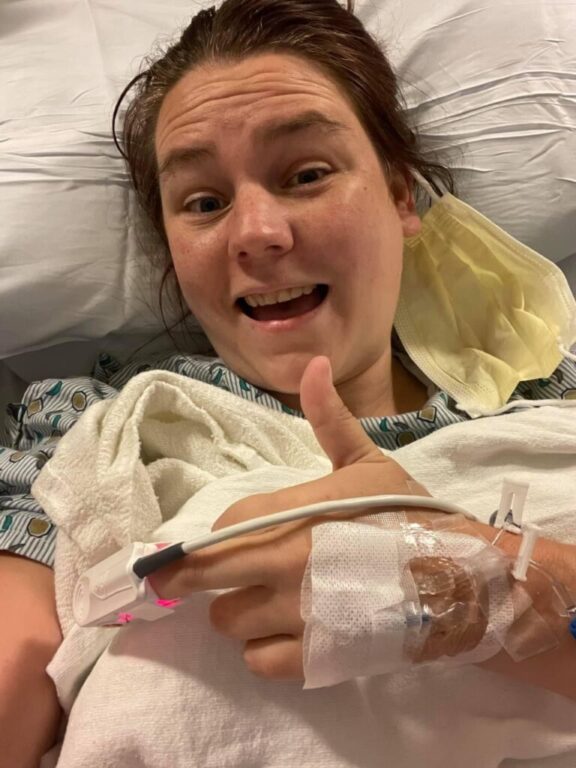Before you read on, make sure to check out Part 1 of our interview. In Part 1, Kyla discusses the two-year diagnostic odyssey that brought her to the point of her Gleich syndrome diagnosis. Today, we’ll discuss what we know about Gleich syndrome so far, as well as the challenges of living with an ultra-rare condition.
Gleich Syndrome: What We Know So Far
Gleich syndrome (which may sometimes be referred to as EAE or Gleich’s syndrome) is a rare eosinophilic disorder characterized by repeated episodes of fever and angioedema. Kyla shares:
“In Gleich syndrome, the muscles in your body become swollen and hardened. It tends to be cyclical. By the time I was at the NIH, my baseline pain and tightness never dropped below a 3 or 4 on the pain scale and would cycle higher up to a 9. I do not have many skin symptoms, but some patients get flushing or red splotches. You can also have GI-related issues as the eosinophils attack soft tissue.
After a second bone marrow test at the NIH, I was in such bad pain that I needed an MRI to make sure that I didn’t have a blood clot. The doctors found inflammation in my muscles and fascia, the tissue that surrounds the muscle, as well as muscle atrophy. Other patients with Gleich syndrome show the same inflammation, so that is probably another symptom that was previously unknown.”
Kyla is one of fifty people diagnosed with Gleich syndrome worldwide and one of 12 being followed by the NIH. Because it is such a rare condition, it is still under-researched and not fully understood. Kyla explains:
“The NIH knows the symptoms and that eosinophils are involved. But they don’t know if eosinophils cause Gleich syndrome or are a byproduct of something different, or if there are disease triggers. I’ve been told that, hopefully, they’ll have a better grasp on the disease and how to help patients within the upcoming 20 years.”
Kyla was placed on an experimental treatment called Nucala (mepolizumab). Although Nucala is not indicated for Gleich syndrome, it is approved for a variety of other eosinophilic disorders. She received 700mg infusions of Nucala every 28 days for two months, then 500mg for two months, then 300mg for two months. While her eosinophils fell to a normal level, her symptoms and flares did not stop. Kyla was pulled off of Nucala and started on high-dose prednisone to carry her over until her next treatment.
Currently, she is taking 5 mg prednisone daily after her doctor lowered the dose. She explains:
“I need my eosinophils to go back up to start the next trial medicine, Ruxolitinib. It is actually used for patients with a bone marrow cancer called myelofibrosis. Instead of looking at the eosinophils as the cause, our next tactic is to try to stop them from being produced and targeting the step before. I’m excited to start the treatment, especially because I’ve been having problems after lowering my prednisone: pain, muscle fatigue, more flares. Sometimes the pain gets so bad that I can’t get out of bed. It hurts to the point that I can’t sleep, so on those days I will take some Benadryl to help sleep, but pain medicine doesn’t help me much.”
The Challenges of Living with an Ultra-Rare Condition
Gleich syndrome is still poorly understood. This can make it difficult for Kyla to determine whether symptoms she feels are related to Gleich syndrome or something else. For example, during the diagnostic process, Kyla had severe stomach pain. She ignored it as she felt like it was most likely related to whatever was going on with her health. When she finally went to the emergency room, the doctors told her that she needed to have her gallbladder removed. Her gallbladder was brown and somewhat degenerated; doctors were shocked, saying that Kyla must have been in pain for quite a while. She says:
“I’m in pain all of the time anyways and it wasn’t that bad compared to my muscle and body pain. So I almost just brushed it off.”

Another challenge that Kyla feels is important to mention is that “invisible” conditions or “invisible” pain can be just as impactful and hard to deal with as more visible conditions. She shares that it can be frustrating when people feel that symptoms are “fake” because she looks outwardly fine. More so, other people attempt to diagnose her with other conditions, saying that they read about symptoms that sounded like hers so she should speak with her doctor. Kyla explains:
“When people see me walking fine one day, and not moving the next, they don’t understand. I know that the questions or suggestions come from a good place, but it makes me feel like they don’t believe me. I just hope that people can recognize that my pain not being visible doesn’t make it any less real.”
Poignant Advice
At the beginning of her journey, Kyla often felt alone, as though nobody was listening to her. She hopes that by sharing her story, and offering advice, she can provide others with some semblance of support and comfort. Her first suggestion is for people to take care of their mental health as well as their physical health:
“Having a chronic, rare, or incurable disease is life-changing. You’ll start to doubt yourself, your relationships, and your body. It’s scary. You feel this sense of isolation and unfairness. I suggest finding a good therapist and getting someone to talk to. This is an important step in navigating this new life.”

Cultivating a strong support system is also imperative. Kyla encourages people to search for online support groups where people can share stories, discuss medications and side effects, and connect with others who understand. Although there is no Gleich syndrome-specific Facebook group, Kyla has found comfort in some more general rare disease groups. On a more in-person level, she says:
“Surround yourself with people who believe and trust you, even if it means limiting time with people who bring you down or make you feel guilty about your diagnosis. You are the only one who knows what you’re going through. Don’t let someone tell you what you have isn’t valid.”







